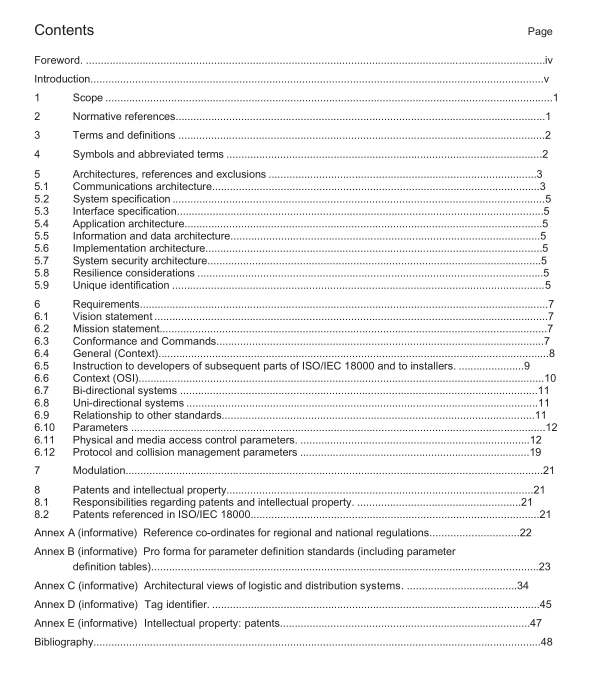BS ISO IEC 18000-1 pdf – Information technology — Radio frequency identification for item management Part 1: Reference architecture and definition of parameters to be standardized

BS ISO IEC 18000-1 pdf – Information technology — Radio frequency identification for item management Part 1: Reference architecture and definition of parameters to be standardized
The communication starts with the master A downloading a message to the slave Az, referring to a list ofpredetermined contexts defined by (Protocol, Encoding, Applications) triplets. The slave, if prepared to handleany of these, can start the transmission referring to the chosen application.
5.1.5 Interaction sequence
An example of the interaction sequence for general distribution logistic model can be defined as described inFigure 3.
The application information flow is not defined herein, but some of these aspects may be addressed insubsequent additions to this part of ISO/IEC 180O0.
5.2System specification
System specification is not defined within ISO/IEC 18000 which relates solely to the interface between aninterrogator and a transponder.
5.3lnterface specification
The subsequent parts of lSO/IEC 18000 (interface specifications at different frequencies) define, describe andspecify interface(s) in physical and procedural terms in conformance to the parameters defined in 5.4 to 5.9.
5.4 Application architecture
Application architecture specification is outside the scope of this version of lSOIEC 18000.Some exampletypical conceptual architecture views and contexts in which RFID for item management are likely to be usedare shown in Annex c.
5.5Information and data architecture
Information/data architecture aspects are addressed in ISO/IEC 15961, Information technology — Radiofrequency identification for item management Data protocol: application interface.
5.6lmplementation architecture
ISOIEC 18000 provides assistance and guidance to those implementing ltem ldentification systems usingRFID. The ‘implementation’ level of architecture is the mapping of functions into physical boxes at one or anumber of locations.These are a function for commercial consideration, rather than standardization, and theimplementation architecture is specifically excluded from ISO/IEC 18000.
5.7System security architecture
System security architecture is not defined within this part of ISO/IEC 18000.5.8Resilience considerations
Resilience considerations are not defined within ISO/IEC 18000.
5.9Unique identification
In subsequent parts of ISOIEC 18000,unique identification (UlI) may be required.Annex D provides apreferred form of UlI. In some parts of ISO/IEC 18000 this may be defined as a normative requirement, inother parts it may be advisory or not preferred. Whether this form of Ull is mandatory,advisory or notapplicable in any specific part is to be stated in the normative clauses of that part of lSOIEC 18000.
6 Requirements
6.1 Vision statement This part of ISO/IEC 18000 defines a common set of parameters that are necessary (at any frequency) in order to avoid contention or interference with other RFID systems, to establish the highest degree of interoperability as is practicable, and to ease migration between technical solutions and their supporting software. The International Standard envisions common methods of determination and description.
6.2 Mission statement The mission of this part of ISO/IEC 18000 is to determine common parameters to be defined in an item identification air interface; the method and means of their definition, and to provide a common format for their elaboration and definition. Subsequent parts of ISO/IEC 18000 will provide the parameter definitions, at different frequencies, for each of the parameters required by this part of ISO/IEC 18000 in accordance with the common format herein determined, and may also, where appropriate, provide regional definitions with geographical constraints. If any parameter defined in this part of ISO/IEC 18000 is inappropriate at a particular frequency, it will be specifically and expressly stated in that part of ISO/IEC 18000 that the named and referenced parameter is not appropriate at that frequency. This part of ISO/IEC 18000 additionally provides relevant information in respect of radio regulations bodies and some examples of conceptual system architectures within which RFID for item identification and management is likely to be used.
6.3 Conformance and Commands 6.3.1 Claiming conformance In order to claim conformance with ISO/IEC 18000 it is necessary to comply to all of the normative clauses of this part of ISO/IEC 18000 except those marked ‘optional’ and it is also necessary to operate within the local national radio regulations (which may require further restrictions) and, if appropriate, to hold a valid licence from the appropriate owner of intellectual property associated with the MODES defined herein.









